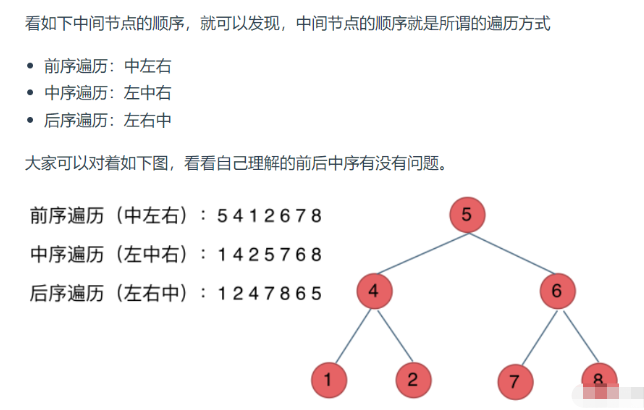Java二叉树的递归和非递归遍历方法是什么
导读:本文共3773.5字符,通常情况下阅读需要13分钟。同时您也可以点击右侧朗读,来听本文内容。按键盘←(左) →(右) 方向键可以翻页。
摘要: 前言二叉树的遍历方法分为前序遍历,中序遍历,后续遍历,层序遍历。1.递归遍历对于递归,就不得不说递归三要素:以前序遍历为例递归入参参数和返回值因为要打印出前序遍历节点的数值,所以参数里需要传入List在放节点的数值,除了这一点就不需要在处理什么数据了也不需要有返回值,所以递归函数返回类型就是void,代码如下:publicvoidpreorder(TreeNod... ...
音频解说
目录
(为您整理了一些要点),点击可以直达。前言
二叉树的遍历方法分为前序遍历,中序遍历,后续遍历,层序遍历。

1.递归遍历
对于递归,就不得不说递归三要素:以前序遍历为例
递归入参参数和返回值
因为要打印出前序遍历节点的数值,所以参数里需要传入List在放节点的数值,除了这一点就不需要在处理什么数据了也不需要有返回值,所以递归函数返回类型就是void,代码如下:
publicvoidpreorder(TreeNoderoot,List<Integer>result)
确定终止条件
在递归的过程中,如何算是递归结束了呢,当然是当前遍历的节点是空了,那么本层递归就要要结束了,所以如果当前遍历的这个节点是空,就直接return
if(root==null)return;
单层循环逻辑
前序遍历是中左右的循序,所以在单层递归的逻辑,是要先取中节点的数值,代码如下:
result.add(root.val);preorder(root.left,result);preorder(root.right,result);
//前序遍历·递归·LC144_二叉树的前序遍历classSolution{publicList<Integer>preorderTraversal(TreeNoderoot){List<Integer>result=newArrayList<Integer>();preorder(root,result);returnresult;}publicvoidpreorder(TreeNoderoot,List<Integer>result){if(root==null){return;}result.add(root.val);//先保存中间节点preorder(root.left,result);//处理左边节点preorder(root.right,result);//处理右边节点}}//中序遍历·递归·LC94_二叉树的中序遍历classSolution{publicList<Integer>inorderTraversal(TreeNoderoot){List<Integer>res=newArrayList<>();inorder(root,res);returnres;}voidinorder(TreeNoderoot,List<Integer>list){if(root==null){return;}inorder(root.left,list);//先处理左边节点list.add(root.val);//保存中间当前的节点inorder(root.right,list);//先处理右边节点}}//后序遍历·递归·LC145_二叉树的后序遍历classSolution{publicList<Integer>postorderTraversal(TreeNoderoot){List<Integer>res=newArrayList<>();postorder(root,res);returnres;}voidpostorder(TreeNoderoot,List<Integer>list){if(root==null){return;}postorder(root.left,list);//先处理左边节点postorder(root.right,list);//再处理右边节点list.add(root.val);//保存最后}}2.非迭代遍历
//前序遍历classSolution{publicList<Integer>preorderTraversal(TreeNoderoot){List<Integer>res=newArrayList<>();Stack<TreeNode>stack=newStack();if(root==null)returnres;stack.push(root);while(!stack.isEmpty()){TreeNodenode=stack.pop();res.add(node.val);if(node.right!=null){//先将右孩子入栈,因为它在最后stack.push(node.right);}if(node.left!=null){//左孩子入栈再出栈stack.push(node.left);}}returnres;}}//中序遍历classSolution{publicList<Integer>inorderTraversal(TreeNoderoot){List<Integer>res=newArrayList<>();if(root==null)returnres;Stack<TreeNode>stack=newStack();TreeNodecur=root;while(cur!=null||!stack.isEmpty()){//如果可以,一直往左下探if(cur!=null){stack.push(cur);cur=cur.left;}else{cur=stack.pop();//弹出来的肯定是叶子节点或中间节点res.add(cur.val);//将这个节点加入listcur=cur.right;//查看当前节点是否有右节点,如果右,肯定是中间节点,如果没有,就是叶子节点,继续弹出就可以}}returnres;}}//后序遍历//再来看后序遍历,先序遍历是中左右,后续遍历是左右中,那么我们只需要调整一下先序遍历的代码顺序,就变成中右左的遍历顺序,然后在反转result数组,输出的结果顺序就是左右中classSolution{publicList<Integer>postorderTraversal(TreeNoderoot){List<Integer>res=newArrayList<>();if(root==null)returnres;Stack<TreeNode>stack=newStack();stack.push(root);while(!stack.isEmpty()){TreeNodenode=stack.pop();res.add(node.val);if(node.left!=null)stack.push(node.left);//相对于前序遍历,这更改一下入栈顺序(空节点不入栈)if(node.right!=null)stack.push(node.right);//空节点不入栈}Collections.reverse(res);//将结果反转之后就是左右中的顺序了returnres;}}3.二叉树的统一迭代法
//前序遍历classSolution{publicList<Integer>preorderTraversal(TreeNoderoot){List<Integer>result=newLinkedList<>();Stack<TreeNode>st=newStack<>();if(root!=null)st.push(root);while(!st.empty()){TreeNodenode=st.peek();if(node!=null){st.pop();//将该节点弹出,避免重复操作,下面再将右中左节点添加到栈中if(node.right!=null)st.push(node.right);//添加右节点(空节点不入栈)if(node.left!=null)st.push(node.left);//添加左节点(空节点不入栈)st.push(node);//添加中节点st.push(null);//中节点访问过,但是还没有处理,加入空节点做为标记。}else{//只有遇到空节点的时候,才将下一个节点放进结果集st.pop();//将空节点弹出node=st.peek();//重新取出栈中元素st.pop();result.add(node.val);//加入到结果集}}returnresult;}}//中序遍历classSolution{publicList<Integer>inorderTraversal(TreeNoderoot){List<Integer>result=newLinkedList<>();Stack<TreeNode>st=newStack<>();if(root!=null)st.push(root);while(!st.empty()){TreeNodenode=st.peek();if(node!=null){st.pop();//将该节点弹出,避免重复操作,下面再将右中左节点添加到栈中if(node.right!=null)st.push(node.right);//添加右节点(空节点不入栈)st.push(node);//添加中节点st.push(null);//中节点访问过,但是还没有处理,加入空节点做为标记。if(node.left!=null)st.push(node.left);//添加左节点(空节点不入栈)}else{//只有遇到空节点的时候,才将下一个节点放进结果集st.pop();//将空节点弹出node=st.peek();//重新取出栈中元素st.pop();result.add(node.val);//加入到结果集}}returnresult;}}//后序遍历classSolution{publicList<Integer>postorderTraversal(TreeNoderoot){List<Integer>result=newLinkedList<>();Stack<TreeNode>st=newStack<>();if(root!=null)st.push(root);while(!st.empty()){TreeNodenode=st.peek();if(node!=null){st.pop();//将该节点弹出,避免重复操作,下面再将右中左节点添加到栈中st.push(node);//添加中节点st.push(null);//中节点访问过,但是还没有处理,加入空节点做为标记。if(node.right!=null)st.push(node.right);//添加右节点(空节点不入栈)if(node.left!=null)st.push(node.left);//添加左节点(空节点不入栈)}else{//只有遇到空节点的时候,才将下一个节点放进结果集st.pop();//将空节点弹出node=st.peek();//重新取出栈中元素st.pop();result.add(node.val);//加入到结果集}}returnresult;}} </div> <div class="zixun-tj-product adv-bottom"></div> </div> </div> <div class="prve-next-news">本文:
Java二叉树的递归和非递归遍历方法是什么的详细内容,希望对您有所帮助,信息来源于网络。